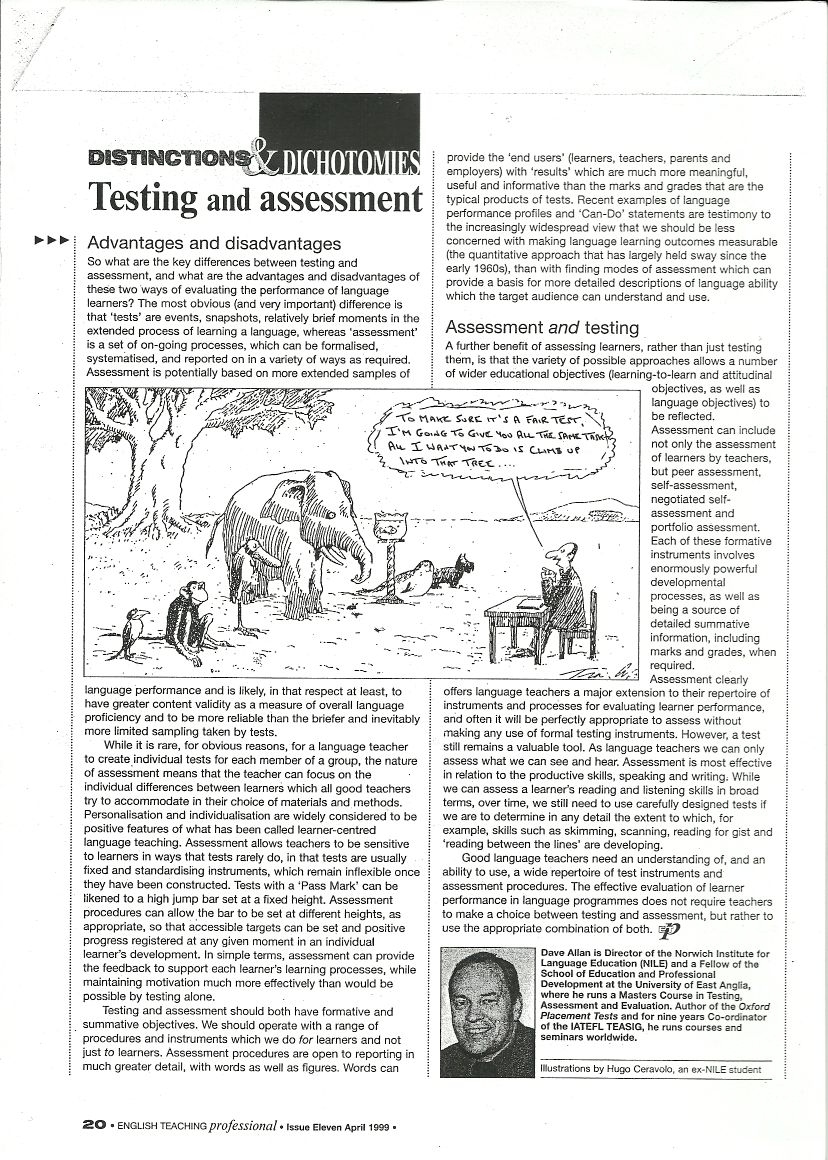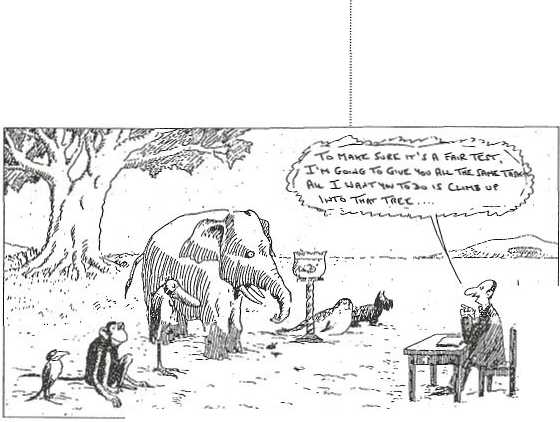Siko0003

i
i
!

MSTINCTION^
Testing and assessment
Advantages and disadvantages
So what are the key dlłferences between testing and assessment, and what are the advantages and dlsadvantages of these two ways of evaluating the performance of language leamers? The most obvlous (and very Important) dlfference Is that ‘tests’ are events, anapshots. relatlvely brie! moments in the extended process of leaming a language. whereas ‘assessment1 is a set of on-going processes, which can be formaSsed, systematised, and reported on in a variety of ways as requłred. Assessment is potentially based on morę extended samples of
!
i

language performance and is fckeły. in that respect at least, to havo greater content validlty as a measure of overall language proficiency and to be morę reliabie than the briefer and inevitably morę limited sampllng taken by tests.
Whlle It is rare, for obvious reasons, for a language teacher to create IndMdual tests for each member of a group, the naturę of assessment means that the teacher can focus on the IndMdual differences botween learners which all good teachers try to accommodate In thelr choice of materlals and methods. Porsonalisation and indMduaisation are wideły considered to be positńre features of what has been cafled leamer-centred language teaching. Assessment alows teachers to be sensrtńre to leamers in ways that tests rareły do, in that tests are usualły fixod and standardising instruments, which remain inflexible once they havo been constructed. Tests with a ‘Pass Marie' can be likened to a high jump bar set at a fixed height. Assessment procedures can allow the bar to be set at different heights, as appropriato, so that accessible targots can be set and positive progress reglstered at any given moment in an individual leamer's development. In simple terms, assessment can provide the feodback to support each learner's learning processes, while maintolning motivation much moro effectlvety than would be possible by testing alone.
Testing and assessment should both have formatlve and summathre objectives. We should operate with a rangę of procedures and instruments which we do for leamers and not just to leamers. Assessment procedures are open to reporting in much greater óetarf, with words as wef as figures Words can
provlde the 'end users' (learners, teachers, parents and employers) with ‘results' which are much morę meanlngful, useful and lnformative than the marks and grades that are the typlcal products of tests. Recent examples of language performance profiles and ‘Can-Do* statements are testimony to the increaslngly widespread view that we should be less concerned with making language learning outeomes measurable (the quantitatlve approach that has largely held sway sińce the early 1960s), than with finding modes of assessment which can provide a basls for morę detailed descrlptlons of language ability which the target audience can understand and use.
Assessment and testing
A furt her beneft of assessing leamers. rather than just testing them, is that the variety of possible approaches allows a number of wider educational ob;ectives (Jear ning-to-learn and attitudinaJ
ob|ectłves, as weil as language objectMes) to bereflected.
Assessment can include not only the assessment of learners by teachers, but peer assessment, aelf-assessment, negotiated self-assossment and portfolio assessment. Each of these formative Instruments involves onormously powerful developmental processes. as wal as being a source of detailed summatńre Information, including marks and grades. when required.
Assessment dearły offers language teachers a major extension to their repertoire of Instruments and processes for evaluating learner performance, and often it will be perfectly appropriate to assess without making any use of formal testing instruments. However, a test still remains a valuabte tool. As language teachers we can only assess what we can see and hear. Assessment is most effective In relation to the productlve skills, speaklng and writing. While we can assess a learners reading and listening skills In broad terms, over tknę. we still need to use carefuky desgned tests if we are to determme in any detafl the extent to which, for exampłe, skills soch as skknming, scanning, reading for gist and ‘reading between the lines' are devetoping.
Good language teachers need an understand ing of. and an ability to use. a wide repertoire of test Instruments and assessment procedures. The effeethre ovaluat*on of leamer periormance in language programmes does not require teachers to make a choice botween testing and assessment, but rather to use the appropriato combinatkm of both. Bp?
Dovo Allan is Director of tho Norwlch Institute for Language Educałlon (NILE) and a Fellow of th« School of Educatlon and Profaasional Dovnlopmenf at Ilia Unlvaralty of East Anglia, whoro he runs a MuMrt Courta in Testing, Assessment and Evałuatton. Author of tho Oxford Ptacmment Tests and for nino years Co-ordnator of tho IATEFL TEASIG. ho runs courses and somlnars worfdwkfo.
■ustratkms by Hugo Coravok>, an «*-MLE ssjcfer:
i
i
20 ■ ENGUSH TEACHINO Professional • Issue Elcvon April 1909
Wyszukiwarka
Podobne podstrony:
36 Yci ypOKM 3Hr/iii/icbKOi mobu. 5 K/iac (3a niflpyHHMKOM O. Kapn iOK) T. So what are the results?
img453 (7) Ali in a days work Speaking 1 Look at the picture. What are the advantages and disadvanta
00407 ?47cae0ff6dbd85a8809e0801a9c9a9 411 Process Capability: Engineering and Statistical Issues al
495Zygmunt Przybycin Investment Projccts and Risk Management Investments are the main way of buildin
IMG 7 1 Describing your Job a Read the texts and matdi them to the pktures. What are the jobs? ip
UHAM102 References and further reading These are the fuli references for the articles mentioned in t
mc03 Which Are the Most Stubbora Musclea? The raus- cles uf the forearm and the cali What Are the Mo
Multimedia What Are the Differences Between the FAT FAT32 and NTFS File Systems Windows supports thr
World History Semester 2 Finał Exam Study Guide Africa What are the differences between a developed
Questions to think about... What are the similarities and differences between food chains and f
2 corrected ISTQB Advanced Level - Test Manager samplePytanie 2 z 65 From a testing perspective, wha
3 corrected ISTQB Advanced Level - Test Manager sample exam - version 2012Pytanie 3 z 65 From a test
Advantages and disadvantages of digital education 25 (for this purpose it is recommended to use the
Obraz (120) ASSESSMENT AND TESTING What is assessment? What are main differences between tests and e
8ANALYSIS, TESTING JPRS-UMS-92-003 16 March 1992 the method of separation of variables and the compu
więcej podobnych podstron